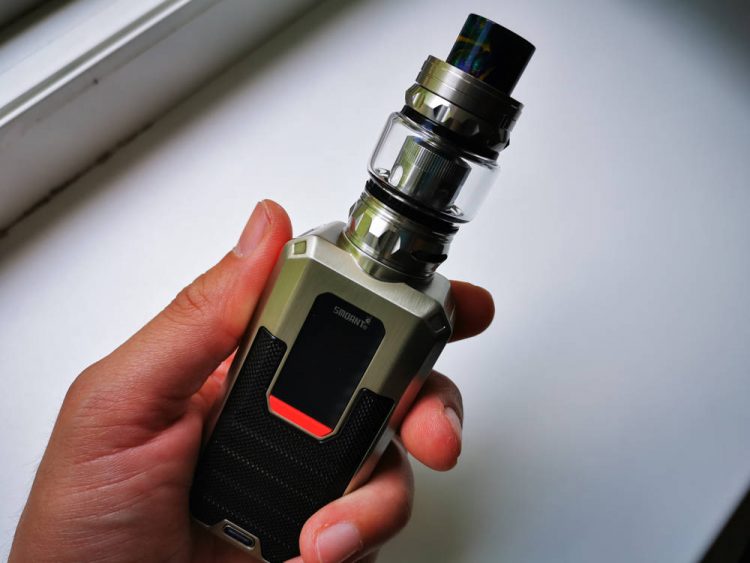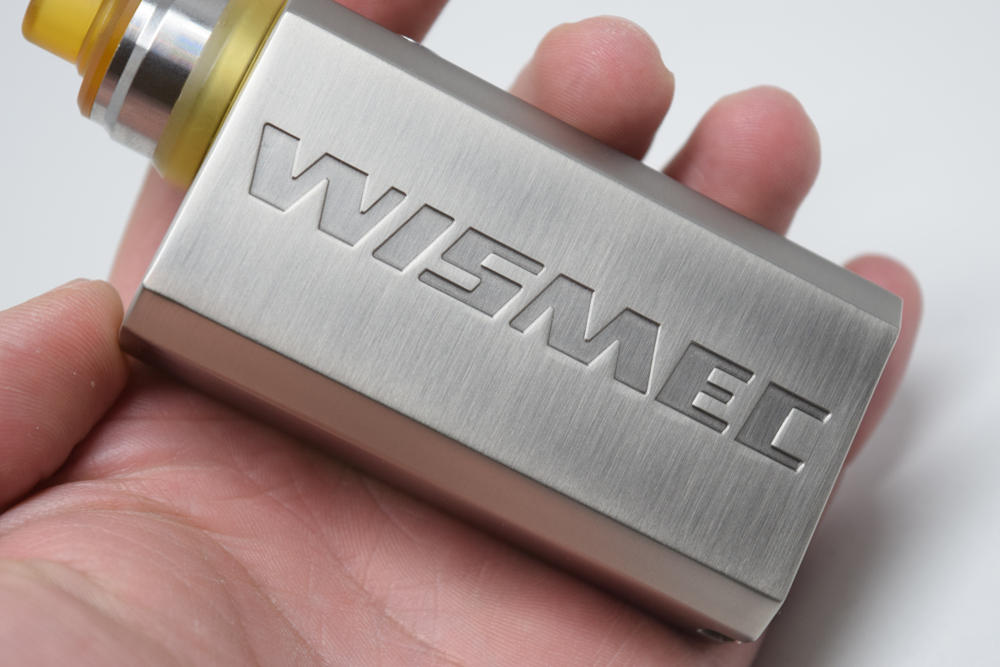Smoant Ladon AIO Tank Review
Smoant was never a big player in the atomizer market, choosing instead to focus on mods and pod systems. They do have a couple of run of the mill sub-ohm tanks in their portfolio, but nothing to right home about. Well, it seems that the Chinese manufacturer is trying to change that, because it recently launched a sub-ohm tank kit complete with a special RBA base that fits both round wire and mesh strip coils.
Smoant Ladon Tank Kit Contents
Named after Smoant’s latest dual-battery mod, the Ladon 225W, this AIO tank kit comes in a standard cardboard box featuring the Ladon tank as well as some branding on the front, and a list of contents, manufacturer contact information, as well as a scratch-and-check authenticity sticker.
Inside the box, we have the tank itself and most of its accessories (two spare glass cylinders, a spare coil-head and a bulky RBA section) placed in a Styrofoam holder, as well as a user manual and a bag of accessories, including organic cotton, a couple of round wire coils and two mesh strips, two different screwdrivers, a small bag of o-rings and gaskets, and spare grub screws for the RBA base.
As you can see, the Ladon kit doesn’t have the AIO (all in one) in its name for nothing; it really has everything you need to start vaping, whether you want to use coil-heads or the RBA.
Smoant Ladon Tank Size and Design
The new Smoant tank is made primarily of stainless steel and glass, comes in only two colors – black and stainless steel – and measures 28mm in diameter (with the bubble glass installed). The Ladon is 58mm tall with either the bubble or straight glass sections, or 63mm, with the special RBA glass installed. It’s not the smallest tank money can buy, that’s for sure, so if you’re looking for something sleek and stealthy, this definitely isn’t it.
Design-wise, nothing really stands out about the Ladon, at least at first sight.apart from the very colorful resin drip tip, slightly slanted airflow slots and the knurling on the base and top cap, it’s a very classic sub-ohm tank design. But there is more to the Ladon AIO tank than meets the eye.
First of all, there is a reason why this tank comes with three different glass tubes – two bubble glass and a standard cylindrical tube. The smaller bubble glass and the straight glass are meant to be used with the coil-heads, while the taller bubble glass is for the RBA. You can’t use the coil-heads with the RBA glass, and you can’t use the rebuildable base with the other two glasses. So make sure you don’t break or lose that tall bubble glass, otherwise you won’t be able to use the RBA anymore.
Then there is the top-filling system, which is very similar to that of the SMOK TFV12 Prince. They both had a small button that you needed to press in order to release a spring-loaded latch and reveal the fill-port. The system implemented on the Ladon tank works just fine, but the problem is that the release button protrudes from the tank a bit too much, so it is easily pressed by mistake. Whether you’re trying to unscrew the top cap to change a coil or the glass section, or you’re carrying the tank in your pocket, there is a good chance the top cap will pop open when you least expect it.
Smoant Ladon Coil-Heads and RBA
As the name suggests, this tank is supposed to be an all-in-one system to cater to all your direct-lung vaping needs. It comes with two mesh coil-heads, one single coil rated at 0.16Ω, and a bulkier dual-mesh coil-head rated at 0.15Ω. They may look different, but in terms of performance, I found them both to be very similar, both in terms of vapor production and flavor. The single-coil one felt a bit more loose on the draw, but the difference, compared to the dual-mesh coil-head, was marginal.
The RBA was going to be the highlight of my experience with the Ladon tank, after all, it’s not every day that you get to review an AIO tank kit. At first, I was really intrigued about the RBA, it looked really beefy and intricate in design, but the more I tinkered with it, the more I realized that it was just unnecessarily complicated.
The Ladon tank RBA is made up of four individual pieces – there is the outer chimney, a press-fit frame that fits onto the top of another frame around the build-deck, and the build-deck itself. So the deck is just a very tiny part in entire ensemble, the rest of which I didn’t really figure out the purpose of. Maybe I’m just not smart enough, but I don’t get what those frames do other than make the whole RBA bulkier for no reason.
Then there is the design of the deck itself. In fact this is the real problem of this RBA. While it is extremely easy to build on, thanks to a very simple post design, whether you’re trying to mount round coils or mesh strips, performance is lackluster because of the airflow. With most coil-head or RBAs, you usually have the airflow coming from underneath and traveling up the chimney, or directly from the side and then up. Well, that’s not the case here…
The Ladon RBA has airflow slots on the base of the build-deck, but they are positioned in such a way that the air does not the hit the heating element when it enters the atomization chamber. Instead it hits the cotton wicking, which makes no sense. According to Smoant’s website, the engineer designed it so the air comes through the holes, makes its way around the cotton wicking, then hits the coil/coils from the sides, before traveling upward through the chimney.
That may sound like an ingenious design on paper, but it doesn’t quite work in real-life conditions. It’s vapeable, no doubt about that, but you get poor airflow whichever type of coil you opt for, and however you decide to wick it. As the air travels around in the RBA, it just doesn’t pick up enough flavor before it reaches your mouth, and you end up with a slightly muted flavor.
The fact that the wicking slots on the side of the RBA are on the slow side doesn’t help much either. You need to be very careful when wicking the Ladon RBA, because too much cotton crammed n those small slants can leas to poor capillary action and ultimately a dry hit. I personally prefer to cut the leads just long enough that they reach the wicking slots, but short enough that the juice can easily permeate the cotton.
The airflow remains the main issue, though, because of how the slots are positioned the air just doesn’t hit the coils the right way and you don’t get the performance you generally expect from an RBA. I don’t know if Smoant is going to release the Ladon AIO tank in this condition, but I honestly hope they rethink the design of their RBA if they ever come out with a second version.
Oh, and they really need to do something about that loose o-ring on the bottom of the RBA, it just won’t stay on. Whether you are trying to take the RBA apart or just mounting it onto the base of the Ladon tank, if you so much as touch that o-ring, it will start to slip off the bottom of the build-deck.
How Does the Smoant Ladon AIO Vape?
When using either of the two coil-heads included in the kit, the Ladon tank performs like a premium sub-ohm tank. The flavor is on point, vapor production is nothing short of impressive, and both the single and dual coil will likely last for over two weeks each, which is not too shabby.
But, to be fair, I was disappointed by the RBA. It was both a mix of high expectations on my part and poor design on the part of the manufacturer, but it just wasn’t what I hope it would be. I tried it both with standard round coils and mesh coils, but the performance was sub-par. Mesh strips were actually worse, because they dried up the cotton wicking faster, and the small wicking slots made it harder for the cotton to absorb enough juice fast enough.
I think Smoant had the right idea when they decided to create this AIO tank kit, it’s just that their execution could have been much better.
Conclusion
The Smoant Ladon AIO Tank is an intriguing project that works well as a standard sub-ohm tank, but falls short in the RBA department, primarily due to poor airflow design. It’s not a terrible products by any means, it’s just that some of the advertised features aren’t as impressive as advertised. Hopefully Smoant revisits their AIO concept in the future, and this time they do airflow properly.
The Smoant Ladon AIO Tank was sent to me directly by Smoant for the purpose of this review.




























I honestly don’t understand your tank reviews.
You give 5 stars to an RBA that is not good by any means and you give 4 stars to some tanks that are good all across the board by your expertise.
I’m absolutely clueless here watching at your tank ranking.
Any idea what metal the mesh is made from in the replacement coils? I can’t find any info on it and want to use the correct setting on my mod. I figure I’ll either need to use “watts” or “Kanthal” but no info seems to be anywhere about the mesh material.